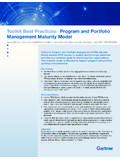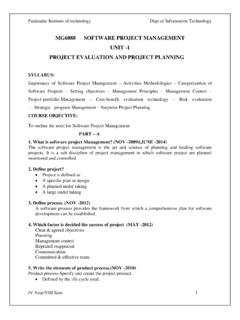Transcription of The Six-Phase Comprehensive Project Life Cycle …
1 1 The Six-Phase Comprehensive Project life Cycle Model Including the Project Incubation/Feasibility Phase and the Post- Project Evaluation Phase Russell D. Archibald1 Ivano Di Filippo2 Daniele Di Filippo3 Abstract A holistic systems perspective of projects and programs is required today to achieve the full benefits of systems thinking4 in Project management. To achieve this perspective, the need to establish a Comprehensive Project life Cycle definition and to promote its application on all important projects is first presented. This Comprehensive Project life Cycle Model recognizes that there is always a Project Incubation/Feasibility Phase prior to the currently existing Project Starting Phase of most Project management (PM) standards, and also recognizes that there must be an additional Post- Project Evaluation Phase after the standard Project Close-out Phase.
2 These phases are defined and discussed for two basic types of projects: 1) delivery or commercial projects and 2) transformational projects. It is recommended that this Comprehensive Project life Cycle Model be considered for adoption as a standard for important projects. While many PM practitioners and authorities limit the scope of Project management to the traditional start-plan-execute-closeout phases , projects begin their existence before the traditional start phase and their products or results continue to exist and must be evaluated after the projects are closed out.
3 The authors assert that these before and after phases must be recognized as belonging within the domain of Project management. Regarding the Post- Project Evaluation Phase the need to differentiate between Project success and Project value is discussed. Acknowledgement: The authors wish to acknowledge with gratitude the comments, suggestions, and criticisms of an earlier version of this paper by Wayne Abba, Franco Caron, Prof. Gianluca Di Castri, Prof. Dr. Jean-Pierre Debourse, Prof. Dr. Harold Kerzner, Prof. Dr. Stanislaw Gasik, David Pells, Dr. Darci Prado, 1 Chairman Emeritus, Archibald Associates; PhD (Hon), MSc, PMP, Fellow PMI, Honorary Fellow APM/IPMA ( ).
4 2 In charge of GenialSoftware, Certified PM and Member, Istituto Italiano di Project Management/ISIPM; in charge of human resources in the Operations Center of Radiotaxi 3570 Roma, Italy. 3 ISIPM member, IT/Engineering Student at Roma3 University in Rome, Italy. 4 Senge, Peter M. (1990), The Fifth Discipline, Doubleday/Currency; Gharajedaghi, Jamshid (1999), Systems Thinking: Managing Chaos and Complexity, Burlington, MA: Butterworth-Heinemann. Genesis of this paper: The authors became acquainted early in 2012 via the Internet through the Istituto Italiano di Project Management/ISIPM LinkedIn discussion group.
5 After an initial on-line exchange of ideas, this multi-generational, multi-cultural trio decided to collaborate to produce this paper. Russell, age 88, an American who has lived in 6 countries on 3 continents, brings a perspective formed by 62 years in engineering, executive, program and Project management across several industries and cultures; Ivano, age 52, an Italian, brings a perspective formed by 20 years in IT, 15 in Project management and 25 years in charge of front-end human resources in the Operations Center of the largest Radiotaxi company in Italy and Europe, in addition to his university student years in the medical field.
6 Daniele, age 22, also Italian and the son of Ivano, has of course grown up in the Digital Age, has a strong interest in human behavior, and completed his university degree in IT engineering in July 2012. This unique combination has produced a team effort that has created the perspectives presented in this paper. Short CVs of each follow the References. 2 Bob Prieto, and Prof. Jorge Tarazona, whose brief CVs are shown in Appendix A. The content remains solely based on the opinions of the authors, however, except where quotations are specifically stated. Part 1. Introduction A company that wants to compete in the international market knows the importance of adopting a Business Process Management (BPM) model as a holistic management approach.
7 The BPM Model is the set of activities needed to define, optimize, monitor and integrate business processes in order to create the desired outcome for each stakeholder. In addition to driving a company s on-going operations, Business Process Management (which includes the concept of Business Performance Management) (Ref. 1) drives its projects and programs, integrated with their multi- Project portfolios to achieve high performance development that is characterized by new success criteria, where Project management metrics are based on performance indices as shown by a matrix between KPIs and CSFs (Ref.)
8 2): Key Performance Indicators (KPIs) are commonly used by an organization to evaluate its success or the success of a particular activity in which it is engaged. Critical success factor (CSF) is the term for an element that is necessary for an organization or Project to achieve its mission successfully, and for ensuring the success of a company. Critical success factors are those few things that must go well to ensure success for a manager or an organization, and therefore they represent those managerial or enterprise areas that must be given special and continual attention to bring about high performance.
9 In achieving improved success in Project , program, and portfolio management there are two desirable goals: A new way to define more broadly and manage more comprehensively the Project life Cycles for both the transformational and the delivery projects and programs within an enterprise; and The proper and effective use of Information Technology (IT) with Business Process Management (BPM) plus Project , Program and Portfolio Management (PPPM.) Use of Information Technology (IT): In order to implement the powerful and widely used Business Process Modeling software systems and the business software systems for managing projects, programs, and their portfolios, we must have integrated information models of those projects and programs.
10 Examples of these software systems (applications) are listed in Appendix B. In fact, these powerful systems are the enablers that make it possible to gain the insights of systems thinking in improving all management processes, procedures, and practices. The greatest challenge in this regard today is to properly integrate Project management software with corporate and operations management software within a large organization5. The full benefits from application of these powerful information systems can only be achieved through development of fully integrated Project life Cycle models that are the subject of this paper.










